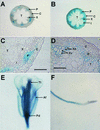Auxin acts in xylem-associated or medullary cells to mediate apical dominance
- PMID: 12566587
- PMCID: PMC141216
- DOI: 10.1105/tpc.007542
Auxin acts in xylem-associated or medullary cells to mediate apical dominance
Abstract
A role for auxin in the regulation of shoot branching was described originally in the Thimann and Skoog model, which proposes that apically derived auxin is transported basipetally directly into the axillary buds, where it inhibits their growth. Subsequent observations in several species have shown that auxin does not enter axillary buds directly. We have found similar results in Arabidopsis. Grafting studies indicated that auxin acts in the aerial tissue; hence, the principal site of auxin action is the shoot. To delineate the site of auxin action, the wild-type AXR1 coding sequence, which is required for normal auxin sensitivity, was expressed under the control of several tissue-specific promoters in the auxin-resistant, highly branched axr1-12 mutant background. AXR1 expression in the xylem and interfascicular schlerenchyma was found to restore the mutant branching to wild-type levels in both intact plants and isolated nodes, whereas expression in the phloem did not. Therefore, apically derived auxin can suppress branching by acting in the xylem and interfascicular schlerenchyma, or in a subset of these cells.
Figures







References
-
- Bangerth, F. (1994). Response of cytokinin concentration in the xylem exudate of bean (Phaseolus vulgaris L.) plants to decapitation and auxin treatment and relationship to apical dominance. Planta 194, 439–442.
-
- Bechtold, N., Ellis, J., and Pelletier, G. (1993). In planta Agrobacterium-mediated gene transfer by infiltration of adult Arabidopsis thaliana plants. C. R. Acad. Sci. Paris 316, 1194–1199.
-
- Beveridge, C.A. (2000). Long-distance signalling and a mutational analysis of branching in pea. Plant Growth Regul. 32, 193–203.
-
- Beveridge, C.A., Murfet, I.C., Kerhoas, L., Sotta, B., Miginiac, E., and Rameau, C. (1997. a). The shoot controls zeatin riboside export from pea roots: Evidence from the branching mutant rms4. Plant J. 11, 339–345.
Publication types
MeSH terms
Substances
LinkOut - more resources
Full Text Sources
Other Literature Sources
Molecular Biology Databases

